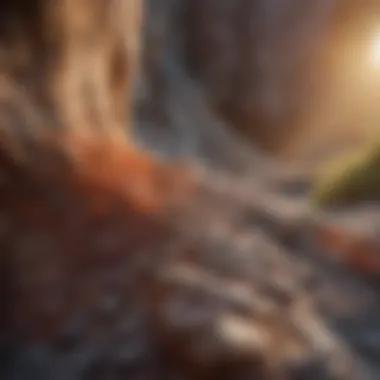Unveiling the Intricacies of Essentials of Geology 13th Edition


Rock and Fossil Identification
Delving into the realm of geology, a meticulous study reveals a vast array of rock formations and fossils waiting to be explored. Understanding the types of rocks and fossils is paramount in deciphering the Earth's history. These specimens offer tangible insights into the planet's evolution over millions of years. Methods for identifying rocks and fossils involve keen observation of key characteristics. By closely examining color, texture, and composition, enthusiasts can classify and categorize these geological remnants. Utilizing specialized tools such as magnifying lenses and hardness picks can further aid in accurate identification.
Collecting Tips and Techniques
For aspiring collectors venturing into the field of geology, honing the art of efficient specimen collection is crucial. Adopting best practices ensures the preservation of geological treasures for future study and appreciation. Recognizing prime collecting sites is a skill acquired through experience and research. These locations, rich in geological history, provide enthusiasts with a wealth of specimens to uncover. When extracting specimens, a delicate touch combined with the right tools is essential to safeguard fragile rocks and fossils.
Preservation and Display
Preserving rocks and fossils is an art that requires attention to detail and proper technique. Employing methods such as casting, consolidation, and protective coatings can extend the lifespan of specimens. Implementing correct storage procedures, including controlled environments and archival materials, prevents deterioration and maintains the integrity of collected rocks and fossils. When it comes to displaying these geological wonders, creativity knows no bounds. From curated shelves to interactive exhibits, showcasing collections can inspire awe and curiosity among viewers.
Geological Insights
Unveiling the mysteries of geological formations and processes unveils a deeper understanding of the Earth's past. Geological formations, such as sedimentary layers and volcanic structures, offer clues to past environmental conditions and catastrophic events. Delving into the historical significance of rocks and fossils sheds light on the evolution of life on Earth and the planet's ever-changing landscape. Notable discoveries in the field of geology continue to shape our perception of the natural world, highlighting the importance of ongoing exploration and study.
Introduction to Essentials of Geology
Exploring the vast world of geology holds immense significance for enthusiasts and scholars alike. The field of geology serves as a portal to understanding the Earth's history, structure, and natural processes. In this article, we embark on an enlightening journey through the 13th edition of Essentials of Geology, unraveling essential concepts and principles that underpin this scientific discipline. By delving into the intricacies of rock formations and geological processes, readers are poised to broaden their knowledge horizon and appreciate the wonders of the geological realm.
Overview of Geology
Definition of Geology
A defining aspect of geology lies in its study of the Earth's processes, materials, and history. The Definition of Geology encapsulates the essence of this scientific field by focusing on the intricate interplay between geological components. By delving deep into the Definition of Geology, readers gain insights into the methods used to unlock the Earth's past and comprehend its present state. This foundational knowledge not only adds depth to geological studies but also paves the way for insightful interpretations of environmental changes and geological phenomena. The Definition of Geology presents a robust framework for understanding the Earth's evolution and dynamics, making it a cornerstone of the Essentials of Geology.
Significance of Studying Geology
The study of geology serves as a vital cornerstone for various scientific disciplines and real-world applications. Understanding the Significance of Studying Geology unravels the mysteries of natural processes, resource management, and environmental conservation. It offers valuable insights into the Earth's past climates, volcanic activities, and tectonic movements, enabling researchers to make informed decisions regarding sustainable practices and disaster mitigation strategies. By comprehending the Significance of Studying Geology, readers can delve into the depths of the Earth's history and unravel the complex web of geological interactions that shape our planet's landscapes. This profound knowledge opens avenues for innovative research and practical solutions in the realm of geology.


Evolution of Geology
Historical Developments
The evolution of geology traces back through centuries of scientific exploration and discovery. Historical Developments in geology have laid the foundation for modern understanding of Earth's processes and structures. From the groundbreaking theories of early geologists to the development of sophisticated dating methods, Historical Developments have shaped the landscape of geological inquiry. By exploring the Historical Developments in geology, readers can appreciate the perseverance and ingenuity of past scientists who unravelled the Earth's mysteries. This retrospective journey serves as a testament to the progressive nature of geological research and the continuous quest for knowledge.
Modern Trends
In the contemporary era, geology has witnessed a paradigm shift with the emergence of Modern Trends that redefine scientific paradigms and methodologies. Modern Trends in geology encompass advanced technologies, interdisciplinary collaborations, and innovative research approaches that propel the field towards new frontiers. By embracing Modern Trends, researchers engage in cutting-edge studies on climate change, natural hazards, and Earth's dynamics, pushing the boundaries of geological knowledge. The integration of modern technologies and analytical tools amplifies the precision and scope of geological investigations, making way for groundbreaking discoveries and transformative insights. Embracing Modern Trends is essential for staying at the forefront of geoscience research and addressing the complex challenges faced by our changing planet.
Fundamental Concepts in Geology
Geological Processes and Features
Geological Processes and Features play a pivotal role in the field of geology, offering indispensable insights into the workings of the Earth's crust. Understanding these processes is crucial for deciphering the formation of various landforms and geological structures. By examining the intricate interplay between geological processes and features, geologists can unravel the Earth's history and predict future changes with precision. This section sheds light on the significance of these processes in the 13th edition of Essentials of Geology, providing readers with a holistic view of the dynamic nature of our planet.
Earth's Interior
Structure of the Earth
The Structure of the Earth is a key focus in geology as it provides valuable information about the composition and layers within the Earth. By studying seismic waves and core samples, scientists have delineated the Earth's layers, including the crust, mantle, outer core, and inner core. This fundamental understanding of the Earth's structure enables geologists to infer processes like plate tectonics and volcanic activity, contributing to a deeper comprehension of geological phenomena. The distinct characteristics of each layer offer unique insights into the Earth's evolution, making the study of its structure imperative in geology.
Mantle Dynamics
Mantle Dynamics explores the movement and behavior of the Earth's mantle, a crucial component in the planet's geophysical processes. The convective currents within the mantle drive plate tectonics, influencing volcanic eruptions, earthquakes, and the creation of new crust. By studying mantle dynamics, geologists can unravel the underlying mechanisms shaping the Earth's surface and subsurface features. This section delves into the complexities of mantle dynamics, highlighting its significance in understanding geological phenomena and Earth's ever-changing landscape.
Landforms and Landscapes
Volcanoes
Volcanoes represent one of the most awe-inspiring geological features, showcasing the Earth's intense geothermal activities. These volcanic structures, ranging from shield volcanoes to stratovolcanoes, offer a glimpse into the planet's fiery core. By examining the formation and eruption patterns of volcanoes, geologists can discern volcanic hazards and mitigate risks associated with volcanic activity. This section delves into the characteristics and impact of volcanoes, shedding light on their crucial role in shaping Earth's topography.


Mountains
Mountains stand as majestic symbols of tectonic forces and erosion, sculpted by millions of years of geological processes. These towering landforms, from fold mountains to fault-block mountains, provide insights into the Earth's crustal movements and structural complexities. By analyzing mountain ranges and their formation, geologists can reconstruct the tectonic history of a region and understand the forces that shape landscapes. This segment explores the unique characteristics of mountains and their significance in geology, offering a comprehensive view of these iconic landforms.
Canyons
Canyons epitomize the erosive power of water, carving deep chasms into the Earth's surface over geologic time. These geological features, characterized by steep cliffs and winding valleys, narrate the story of relentless erosion and tectonic uplift. By studying the formation of canyons and their geological significance, geologists can unravel past environmental conditions and the impact of erosion on landscapes. This section delves into the formation processes of canyons, highlighting their geological importance and the insights they provide into Earth's dynamic surface.
Weathering and Erosion
Physical Weathering
Physical Weathering exemplifies the breakdown of rocks and minerals due to mechanical forces like frost action and root wedging. This process plays a crucial role in soil formation and the disintegration of rocks into sediments. By examining the different mechanisms of physical weathering, geologists can elucidate the effects of climate and topography on rock degradation, enriching our understanding of Earth's surface processes. This segment delves into the significance of physical weathering in geology, emphasizing its role in shaping landscapes and geological formations.
Chemical Weathering
Chemical Weathering involves the alteration of rocks and minerals through chemical reactions, such as hydrolysis and oxidation. This process impacts the composition of rocks, leading to the formation of new minerals and soil deposits. By studying chemical weathering processes, geologists can infer past environmental conditions and the weathering history of a region. This section explores the mechanisms and outcomes of chemical weathering, underscoring its importance in geology and landscape evolution.
Erosion Processes
Erosion Processes are fundamental in reshaping the Earth's surface through the removal and transportation of sediments by water, wind, or ice. These processes sculpt valleys, cliffs, and deltas, contributing to the continuous transformation of landscapes. By examining erosion mechanisms like abrasion and deposition, geologists can map out the evolution of landforms and predict future changes caused by erosion. This segment delves into the diverse erosion processes at work in geology, highlighting their role in shaping the Earth's topography and geological features.
Geological Time Scale
In the realm of geology, the Geological Time Scale stands as a pillar of understanding the Earth's history 🌍. It delineates critical events and transitions that have shaped the planet over billions of years. One cannot grasp the complexities of Earth's past without reference to this scale. By categorizing time into eras and periods, scientists can correlate geological and biological events. Understanding this scale is fundamental for decoding the Earth's ancient narratives.
Eras and Periods
- Precambrian: The Precambrian era holds a paramount position in geological timelines 🕰️. It encompasses nearly 88% of Earth's history and sets the stage for life's emergence. Despite its considerable span, Precambrian remains enigmatic due to limited fossil records. This era's significance lies in revealing Earth's initial formations, highlighting its primordial geophysical processes and environments. Studying Precambrian offers a glimpse into the planet's infancy, showcasing its transformation towards habitability.
- Paleozoic: The Paleozoic era marks a pivotal period in Earth's evolution 🦕. Known for the rise of complex life forms like trilobites and early fish, it signifies the transition from primitive to diverse biological communities. A key characteristic of the Paleozoic is the abundance of marine life and the proliferation of plants on land. Its appearance in this article serves to underscore the foundational role it played in shaping future ecosystems and setting the stage for subsequent geological developments.
- Mesozoic: Entering the Mesozoic era ushers us into the age of dinosaurs 🦖. Characterized by the dominance of reptiles, this era witnesses the evolution of avian and terrestrial giants. The Mesozoic's allure lies in its notorious creatures like the T. rex and Brachiosaurus, captivating researchers and enthusiasts alike. Its portrayal in this article accentuates its charm and scientific significance in unraveling the mysteries of ancient habitats and geological shifts.
- Cenozoic: The Cenozoic era represents the stage where modern biodiversity flourished 🌿. As the era of mammals, it houses the development of humanoids and contemporary flora and fauna. The key characteristic of the Cenozoic is the prevalence of familiar species, from primates to flowering plants. Its feature in this article aims to spotlight the era's relevance in understanding current geological phenomena and predicting future environmental trends.


Dating Methods
Unraveling the Earth's timeline relies on robust dating methods that scrutinize geologic materials with precision 🔎. These methods serve as investigative tools to ascertain the ages of rocks and fossils, aiding in reconstructing past events with accuracy. By seamlessly integrating relative and absolute dating techniques, geologists can piece together the Earth's chronology log.
Relative Dating
Relative Dating employs stratigraphy to determine the sequential order of rock layers 🪨. This technique relies on the principle of superposition, where older layers lie beneath younger ones. By analyzing the relative positions of these strata, geologists can infer the temporal sequence of events. Relative Dating's utility stems from its ability to establish a relative timeline, offering insights into the Earth's sedimentary history and geological transformations.
- Absolute Dating: Absolute Dating employs radiometric techniques like carbon dating to assign numerical ages to rocks and fossils ⏳. By measuring the decay of radioactive isotopes within minerals, geoscientists can calculate precise ages for geological specimens. This method's advantage lies in providing actual numerical values, enabling researchers to pinpoint specific geological events and biological timelines. Absolute Dating's strategic inclusion in this article underscores its crucial role in anchoring geological investigations and unraveling the Earth's antiquity.
Environmental Geology
Environmental Geology holds a paramount position in the realm of geological studies, shedding light on the intricate relationship between Earth's processes and human activities. This 13th edition of Essentials of Geology intricately delves into the critical aspects of Environmental Geology, emphasizing its significance in understanding and addressing environmental challenges. The section offers a profound exploration of topics like climate change, natural resource depletion, and geological hazards, equipping readers with valuable insights for informed decision-making and sustainable practices.
Human Impact on Geology
Climate Change
Climate Change stands out as a pivotal subject within the scope of Environmental Geology, resonating with the urgent call for environmental conservation. Its portrayal in this article underscores the profound consequences of anthropogenic activities on Earth's climate system. By highlighting the alarming rise in global temperatures, shifting weather patterns, and melting ice caps, this section illuminates Climate Change's undeniable impact on geological processes and landscapes. Readers will grasp the intricate interplay between human actions and environmental repercussions, accentuating the necessity for proactive measures and eco-conscious initiatives.
Natural Resource Depletion
Natural Resource Depletion emerges as a defining challenge in Environmental Geology, encapsulating the diminishing availability of vital resources due to excessive exploitation. This segment elucidates the repercussions of unchecked resource extraction on geological stability and ecosystem equilibrium. By unraveling the complexities of resource scarcity, habitat degradation, and biodiversity loss, the article accentuates the dire need for sustainable resource management strategies. Readers will gain a nuanced perspective on the intricacies of Natural Resource Depletion, prompting reflection on responsible resource utilization and conservation efforts.
Geological Hazards
Earthquakes
Earthquakes, as a fundamental geological hazard, occupy a central role in Environmental Geology discussions, emphasizing the seismic vulnerabilities of Earth's crust. This section delineates the destructive potential of earthquakes, delineating their causes, impacts, and seismic monitoring techniques. By delineating the geological processes underlying seismogenesis, readers will discern the seismic threats faced by vulnerable regions worldwide. The narrative underscores the imperative of earthquake preparedness and mitigation strategies, fostering resilience in communities exposed to seismic risks.
Volcanic Activity
Volcanic Activity emerges as a dynamic geological phenomenon with far-reaching implications for Environmental Geology, portraying the volcanic processes shaping Earth's topography. This segment elucidates the geothermal manifestations of volcanic eruptions, highlighting their geological significance and hazard potential. By elucidating the volcanic hazards posed to human settlements and ecosystems, readers will appreciate the volatile nature of volcanic landscapes. The narrative advocates for proactive volcanic risk assessment and emergency preparedness measures to mitigate the impact of volcanic events.
Landslides
Landslides stand as pervasive geological hazards that warrant attention in the realm of Environmental Geology, showcasing the geomorphological consequences of slope failures. This section unveils the triggers, mechanisms, and landsliding factors contributing to slope instability and mass wasting phenomena. By unveiling the environmental repercussions of landslides on landscapes and communities, readers will grasp the significance of landslide susceptibility mapping and hazard zonation. The narrative emphasizes the need for sustainable land-use practices and engineering solutions to minimize landslide risks and ensure landscape resilience.







